Tensile Properties and Tensile Failure Criteria of Layered Rocks
Abstract
:1. Introduction
2. Experimental Study on Layered Rocks by the Brazilian Test
2.1. Test Equipment and Samples
2.2. Failure Mode of the Shale Samples
2.3. Tensile Strength of the Shale Samples
3. Numerical Study of Layered Rocks
3.1. Description of the Numerical Code
3.2. Brazilian Disc Test of Layered Rock Specimens by RFPA2D
3.2.1. Numerical Layered Specimens of Brazilian Test
3.2.2. Results and Analysis
3.3. Direct Tension Test on Layered Rock Samples by RFPA2D
3.3.1. Preparation of the Numerical Layered Specimens
3.3.2. Results and Analysis
3.3.3. Failure Mechanism
3.4. Discussion
3.4.1. Failure Modes of Layered Rock Specimens under Direct Tension Test
3.4.2. Tensile Strength of Layered Rock Specimens
4. Modified Anisotropic Tensile Failure Criterion
4.1. Single Plane of Weakness (SPW) Criterion
4.2. Modified SPW Criterion (MSPW Criterion)
4.3. Verification of the MSPW Criterion
4.4. Determination of the Tensile Strength of Layered Rocks
5. Conclusions
- (1)
- The layered rock specimens display an anisotropic mechanical behavior when subjected to direct tension load. The tensile stress–strain behavior of the layered rocks depends on the direction of the bedding planes with respect to the tensile load. However, the direct tension test of layered rocks in the laboratory needs to be studied in more depth in the future.
- (2)
- The numerical results show that the dip angle has a significant influence on the fracture characteristics during the progressive failure, such as peak strength, failure patterns, and deformational behavior. The failure modes of the layered rock specimens are characterized by tensile failure along the bedding plane, progressive saw-toothed failure, and tensile failure of the rock material under direct tension.
- (3)
- Based on the failure modes of the layered rocks, the SPW failure criterion is modified. The theoretical results of the modified SPW (MSPW) failure criterion show a good agreement with the experimental and the numerical results. The MSPW failure criterion can accurately describe the tensile strength when the dip angle of the bedding plane is close to .
- (4)
- Based on the MSPW criterion, a method to determine the tensile strength of the layered rocks is proposed, which can simply predict the tensile strength of the layered rocks.
Author Contributions
Funding
Institutional Review Board Statement
Informed Consent Statement
Data Availability Statement
Conflicts of Interest
References
- Donath, F.A. Strength variation and deformational behavior in anisotropic rock. In State of Stress in the Earth Crust; Judd, W.R., Ed.; Elsevier: Amsterdam, The Netherlands, 1964; pp. 281–300. [Google Scholar]
- Amadei, B.; Rogers, J.D.; Goodman, R.E. Elastic constants and tensile strength of the anisotropic rocks. In Proceedings of the Fifth Congress of International Society of Rock Mechanics, Melbourne, Australia, 10–15 April 1983; Balkema: Rotterdam, The Netherlands, 1983; pp. 189–196. [Google Scholar]
- Amadei, B. Importance of anisotropy when estimating and measuring in situ stresses in rock. Int. J. Rock Mech. Min. Sci. Geomech. Abstr. 1996, 33, 293–325. [Google Scholar] [CrossRef]
- Gao, M.; Liang, Z.Z.; Jia, S.P.; Li, Y.C.; Yang, X.X. An equivalent anchoring method for anisotropic rock masses in underground tunnelling. Tunn. Undergr. Space Technol. 2019, 85, 294–306. [Google Scholar] [CrossRef]
- Yagiz, S. Utilizing rock mass properties for predicting TBM performance in hard rock condition. Tunn. Undergr. Space Technol. 2008, 23, 326–339. [Google Scholar] [CrossRef]
- Singh, T.N.; Pradhan, S.P.; Vishal, V. Stability of slopes in a fire-prone mine in Jharia Coalfield, India. Arab. J. Geosci. 2013, 6, 419–427. [Google Scholar] [CrossRef]
- Mclamore, P.B.; Gray, K.E. The mechanical behaviour of anisotropic sedimentary rocks. J. Eng. Ind. 1967, 89, 62–76. [Google Scholar] [CrossRef]
- Tien, Y.M.; Tsao, P.F. Preparation and mechanical properties of artificial transversely isotropic rock. Int. J. Rock Mech. Min. Sci. 2000, 37, 1001–1012. [Google Scholar] [CrossRef]
- Jaeger, J.C.; Cook, N.G.W.; Zimmerman, R.W. Fundamentals of Rock Mechanics, 4th ed.; Blackwell Publishing: Malden, MA, USA, 2007. [Google Scholar]
- Aadnoy, B.; Looyeh, R. Petroleum Rock Mechanics: Drilling Operations and Well Design; Gulf Professional Publishing: Oxford, UK, 2011. [Google Scholar]
- Wu, N.; Liang, Z.Z.; Li, Y.C.; Li, H.; Li, W.R.; Zhang, M.L. Stress-dependent anisotropy index of strength and deformability of jointed rock mass: Insights from a numerical study. Bull. Eng. Geol. Environ. 2019, 78, 5905–5917. [Google Scholar] [CrossRef]
- Guo, F.; Liang, Z.Z.; Gong, B.; Li, G. Tensile failure in stability analysis of rock and soil slopes. Chin. J. Rock Mech. Eng. 2017, 36, 3192–3205. (In Chinese) [Google Scholar]
- Chen, Y.L.; Azzam, R.; Wang, M.; Xu, S.; Chang, L.Q. The uniaxial compressive and tensile tests of frozen saturated clay in Shanghai area. Environ. Earth Sci. 2011, 64, 29–36. [Google Scholar] [CrossRef]
- ISRM. Suggested methods for determining tensile strength of rock materials. Int. J. Rock Mech. Min. Sci. Geomech. Abstr. 1978, 15, 99–103. [Google Scholar] [CrossRef]
- Hobbs, D.W. Rock tensile strength and its relationship to a number of alternative measures of rock strength. Int. J. Rock Mech. Min. Sci. Geomech. Abstr. 1967, 4, 115–127. [Google Scholar] [CrossRef]
- Li, D.Y.; Wong, L.N.Y. The Brazilian disc test for rock mechanics applications: Review and new insights. Rock Mech. Rock Eng. 2013, 46, 269–287. [Google Scholar] [CrossRef]
- Wu, B.; Chen, R.; Xia, K. Dynamic tensile failure of rocks under static pretension. Int. J. Rock Mech. Min. Sci. 2015, 80, 12–18. [Google Scholar]
- Bai, Q.S.; Tu, S.H.; Zhang, C. DEM investigation of the fracture mechanism of rock disc containing holes and its influence on tensile strength. Theor. Appl. Fract. Mech. 2016, 86, 197–216. [Google Scholar] [CrossRef]
- Khosravi, A.; Simon, R.; Rivard, P. The shape effect on the morphplogy of the fracture surface induced by the Brazilian test. Int. J. Rock Mech. Min. Sci. 2016, 93, 201–209. [Google Scholar] [CrossRef]
- Xia, K.; Yao, W.; Wu, B. Dynamic rock tensile strengths of Laurentian granite: Experimental observation and micromechanical model. J. Rock Mech. Geotech. Eng. 2017, 9, 116–124. [Google Scholar] [CrossRef]
- Yuan, R.; Shen, B. Numerical modelling of the contact condition of a Brazilian disk test and its influence on the tensile strength of rock. Int. J. Rock Mech. Min. Sci. 2017, 93, 54–65. [Google Scholar] [CrossRef]
- Zhang, S.W.; Shou, K.J.; Xian, X.F.; Zhou, J.P.; Liu, G.J. Fracture characteristics and acoustic emission of anisotropic shale in Brazilian tests. Tunn. Undergr. Space Technol. 2018, 71, 366–381. [Google Scholar] [CrossRef]
- Wang, P.T.; Cai, M.F.; Ren, F.H. Anisotropic and directionality of tensile behaviours of a jointed rock mass subjected to numerical Brazilian tests. Tunn. Undergr. Space Technol. 2018, 73, 139–153. [Google Scholar] [CrossRef]
- Barla, G.; Innaurato, N. Indirect tensile testing of anisotropic rocks. Rock Mech. 1973, 5, 215–230. [Google Scholar] [CrossRef]
- Debecker, B.; Vervoort, A.; Napier, J.A.L. Fracturing in and around a natural discontinuity in rock: A comparison between boundary and discrete element models. In Proceedings of the 5th International Conference on Engineering Computational Technology, Las Palmas, Spain, 12–15 September 2006; p. 186. [Google Scholar]
- Debecker, B.; Vervoort, A. A Two-dimensional discrete element simulations of the fracture behavior of slate. Int. J. Rock Mech. Min. Sci. 2013, 61, 161–170. [Google Scholar] [CrossRef]
- Park, B.; Min, K.B. Discrete element modeling of transversely isotropic rock. In Proceedings of the 47th US Rock Mech/Geomech Symp ARMA, San Francisco, CA, USA, 23–26 June 2013; Volume 13, p. 490. [Google Scholar]
- Dan, D.Q.; Konietzky, H.; Herbust, M. Brazilian tensile strength tests on some anisotropic rocks. Int. J. Rock Mech. Min. Sci. 2013, 58, 1–7. [Google Scholar] [CrossRef]
- Dan, D.Q.; Konietzky, H. Numerical simulations and interpretations of Brazilian tensile tests on transversely isotropic rocks. Int. J. Rock Mech. Min. Sci. 2014, 71, 53–63. [Google Scholar] [CrossRef]
- Liu, S.Y.; Fu, H.L.; Rao, J.Y.; Dong, H.; Cao, Q. Research on Barzilian disc splitting tests for anisotropy of slate under influence of different bedding orientations. Chin. J. Rock Mech. Eng. 2012, 31, 785–791. (In Chinese) [Google Scholar]
- Vervoort, A.; Min, K.B.; Konietzky, H.; Cho, J.W.; Debecker, B.; Dinh, Q.D.; Fruhwirt, T.; Tavallali, A. Failure of transversely isotropic rock under Brazilian test conditions. Int. J. Rock Mech. Min. Sci. 2014, 70, 343–352. [Google Scholar] [CrossRef]
- Chong, Z.H.; Li, X.H.; Hou, P.; Wu, Y.C.; Zhang, J.; Chen, T.; Liang, S. Numerical investigation of bedding plane parameters of transversely isotropic shale. Rock Mech. Rock Eng. 2017, 50, 1183–1204. [Google Scholar] [CrossRef]
- Xu, G.W.; He, C.; Chen, Z.Q.; Su, A. Transversely isotropy of phyllite under Brazilian tests: Laboratory testing and numerical simulations. Rock Mech. Rock Eng. 2018, 51, 1111–1135. [Google Scholar] [CrossRef]
- Kundu, J.; Mahanta, B.; Sarkar, K.; Singh, T.N. The effect of lineation on anisotropic in dry and saturated Himalayan schistose rock under Brazilian test conditions. Rock Mech. Rock Eng. 2018, 51, 5–21. [Google Scholar] [CrossRef]
- Wijk, G. Some new theoretical aspects of indirect measurements of tensile strength of rocks. Int. J. Rock Mech. Min. Sci. Geomech. Abstr. 1978, 15, 149–160. [Google Scholar] [CrossRef]
- ASTM D3967-16; Standard Test Method for Splitting Tensile Strength of Intact Core Specimens. ASTM International: West Conshohocken, PA, USA, 2001.
- Aliha, M.R.M. Indirect tensile test assessment for rock materials using 3-D disc-type specimens. Arab. J. Geosci. 2014, 7, 4757–4766. [Google Scholar] [CrossRef]
- Karaman, K.; Kesimal, A.; Ersoy, H. A comparative assessment of indirect methods for estimating the uniaxial compressive and tensile strength of rocks. Arab. J. Geosci. 2015, 8, 2393–2403. [Google Scholar] [CrossRef]
- Youash, Y. Tension Tests on Layered Rocks. Geol. Soc. Am. Bull. 1969, 80, 303–306. [Google Scholar] [CrossRef]
- Liao, J.J.; Tang, M.T.; Hsieh, H.Y. Direct tensile behavior of a transversely isotropic rock. Int. J. Rock Mech. Min. Sci. 1997, 34, 837–849. [Google Scholar] [CrossRef]
- Barron, K. Brittle fracture initiation in and ultimate failure of rocks: Part II-Anisotropic rocks: Theory. Int. J. Rock Mech. Min. Sci. Geomech. Abstr. 1971, 8, 553–563. [Google Scholar] [CrossRef]
- Nova, R.; Zaninetti, A. An investigation into the tensile behaviour of a schistose rock. Int. J. Rock Mech. Min. Sci. Geomech. Abstr. 1990, 27, 231–242. [Google Scholar] [CrossRef]
- Lee, Y.K.; Pietruszczak, S. Tensile failure criterion for transversely isotropic rocks. Int. J. Rock Mech. Min. Sci. 2015, 79, 205–215. [Google Scholar] [CrossRef]
- Ma, T.S.; Wu, B.S.; Fu, J.H.; Zhang, Q.G.; Chen, P. Fracture pressure prediction for layered formations with anisotropic rock strengths. J. Nat. Gas Sci. Eng. 2017, 38, 485–503. [Google Scholar] [CrossRef]
- Ma, T.S.; Zhang, Q.B.; Chen, P.; Yang, C.H.; Zhao, J. Fracture pressure model for inclined wells in layered formations with anisotropic rock strengths. J. Pet. Sci. Eng. 2017, 149, 393–408. [Google Scholar] [CrossRef]
- Shang, J.; Duan, K.; Cui, Y.; Handley, K.; Zhao, Z. Numerical investigation of the direct tensile behaviour of laminated and transversely isotropic rocks containing incipient bedding planes with different strengths. Comput. Geotech. 2018, 104, 373–388. [Google Scholar] [CrossRef] [Green Version]
- Tang, C.A. Numerical simulation of progressive rock failure and associated seismicity. Int. J. Rock Mech. Min. Sci. 1997, 34, 249–261. [Google Scholar] [CrossRef]
- Chen, C.S.; Pan, E.; Amadei, B. Determination of deformability and tensile strength of anisotropic rock using Brazilian tests. Int. J. Rock Mech. Min. Sci. 1998, 35, 43–61. [Google Scholar] [CrossRef]
- Tavallali, A.; Vervoort, A. Failure of layered sandstone under Brazilian test conditions: Effect of micro-scale parameters on macro-scale behavior. Rock Mech. Rock Eng. 2010, 43, 641–653. [Google Scholar] [CrossRef]
- Tavallali, A.; Vervoort, A. Effect of layered orientation on the failure of layered sandstone under Brazilian test conditions. Int. J. Rock Mech. Min. Sci. 2010, 47, 313–322. [Google Scholar] [CrossRef]
- Tavallali, A.; Vervoort, A. Behaviour of layered sandstone under Brazilian test conditions: Layered orientation and shape effects. J. Rock Mech. Geotech. Eng. 2013, 5, 366–377. [Google Scholar] [CrossRef] [Green Version]
- Khanlari, G.; Rafiei, B.; Abdilor, Y. An experimental investigation of the Brazilian tensile strength and failure patterns of Laminated sandstones. Rock Mech. Rock Eng. 2015, 48, 843–852. [Google Scholar] [CrossRef]
- Tan, X.; Konietzky, H.; Fruhwirt, T.; Dan, D.Q. Brazilian tests on transversely isotropic rocks: Laboratory testing and numerical simulations. Rock Mech. Rock Eng. 2015, 48, 1341–1351. [Google Scholar] [CrossRef]
- Cho, J.W.; Kim, H.; Jeon, C.K.; Min, K.B. Deformation and strength anisotropy of Asian gneiss, Boryeong shale, and Yeoncheon schist. Int. J. Rock Mech. Min. Sci. 2012, 50, 158–169. [Google Scholar] [CrossRef]
- Simpson, N.D.J. An Analysis of Tensile Strength, Fracture Initiation and Propagation in Anisotropic Rock (Gas Shale) Using Brazilian Test Equipped with High Speed Video and Acoustic Emission. Master’s Thesis, Norwegian University of Science and Technology, Trondheim, Norway, 2013. [Google Scholar]
- Deng, H.F.; Zhang, X.J.; Zhang, H.B.; Wang, C.X.J.; Fang, J.C.; Xiao, Y. Analysis and discussion on Brazilian tests on layered rock tensile strength. Rock Soil Mech. 2016, 37, 309–316. (In Chinese) [Google Scholar]
- Wang, P.T.; Yang, T.H.; Xu, T.; Yu, Q.L.; Liu, H.L. A model of anisotropic property of seepage and stress for jointed rock mass. J. Appl. Math. 2013, 2013, 420536. [Google Scholar] [CrossRef]
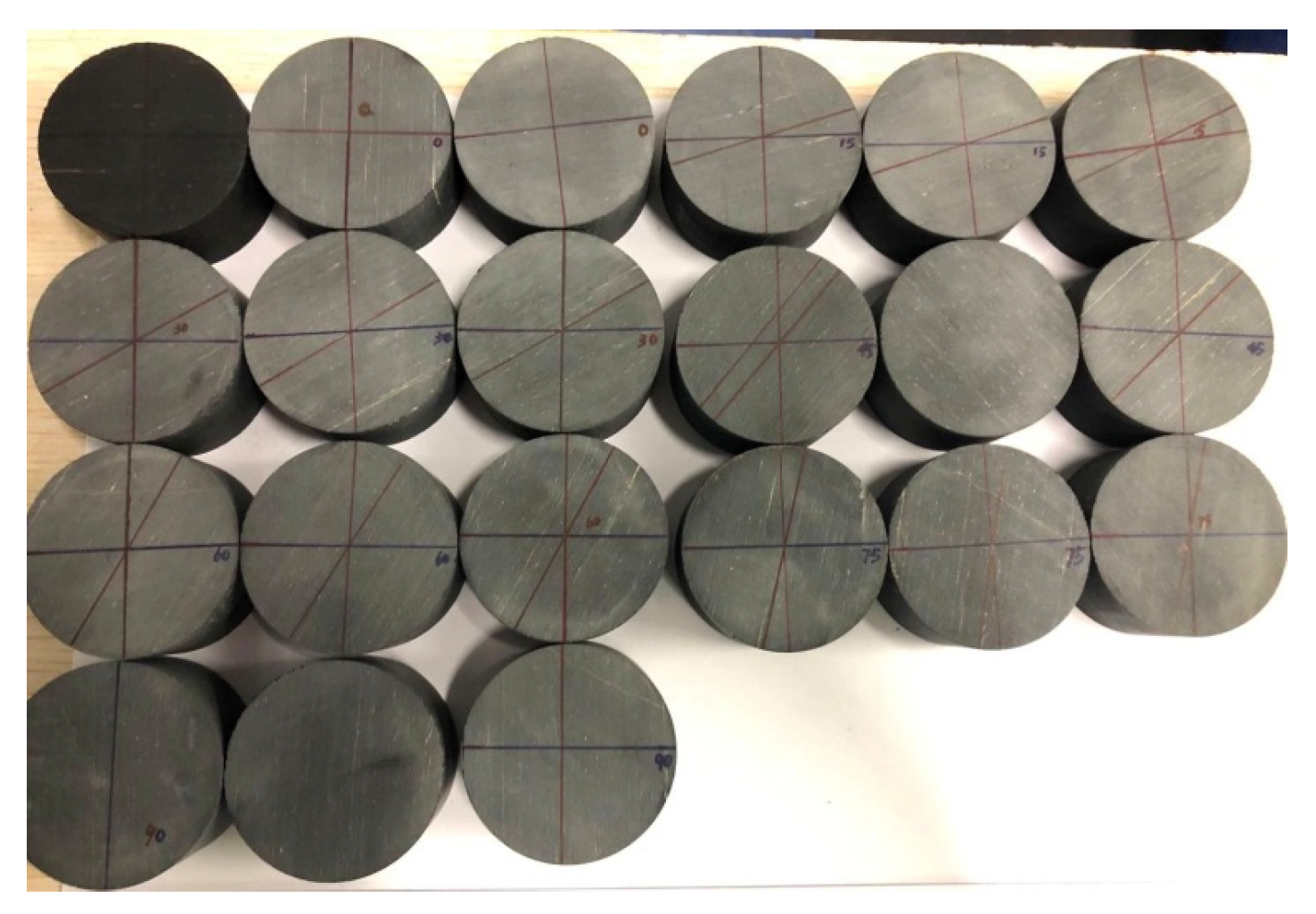
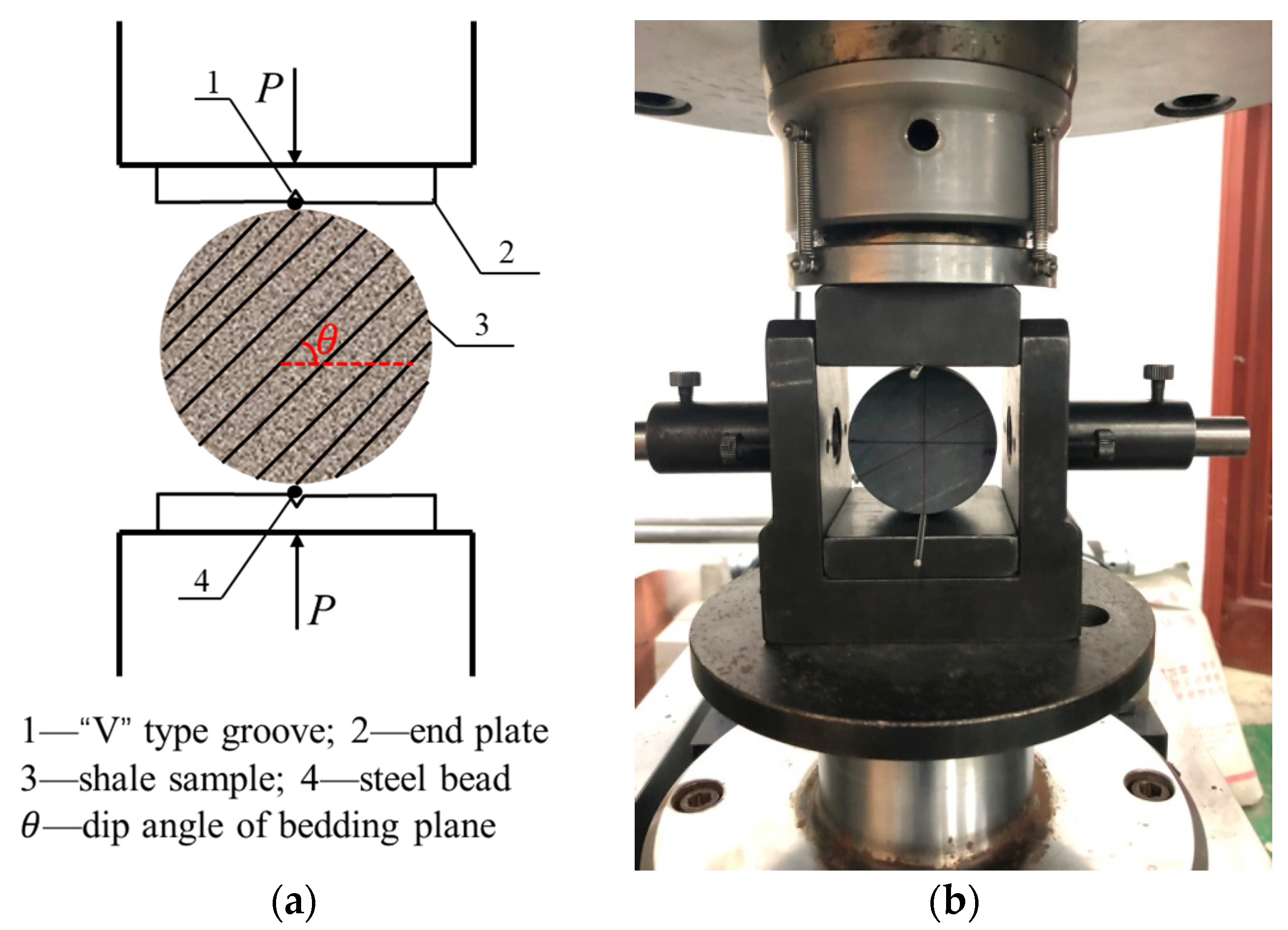
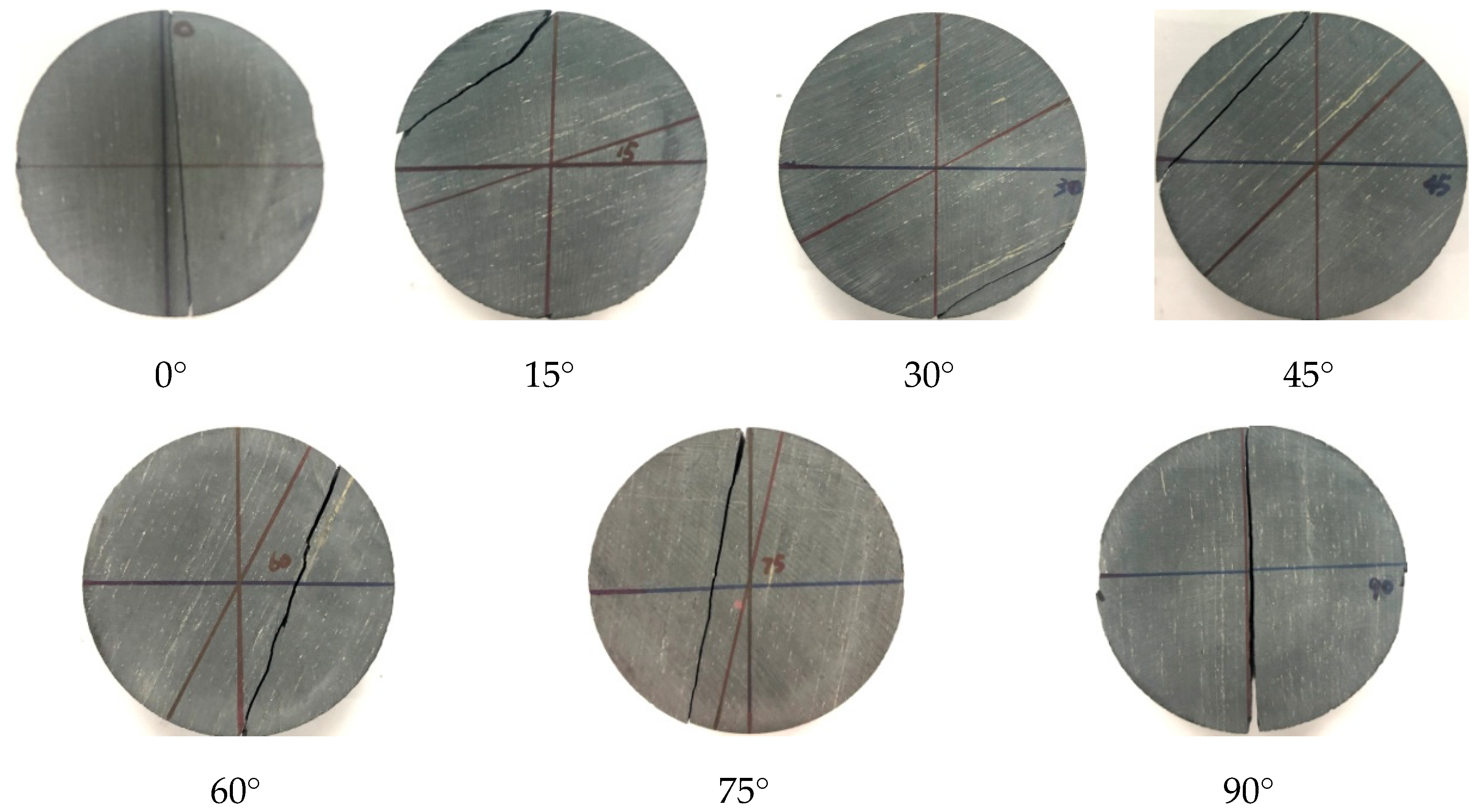
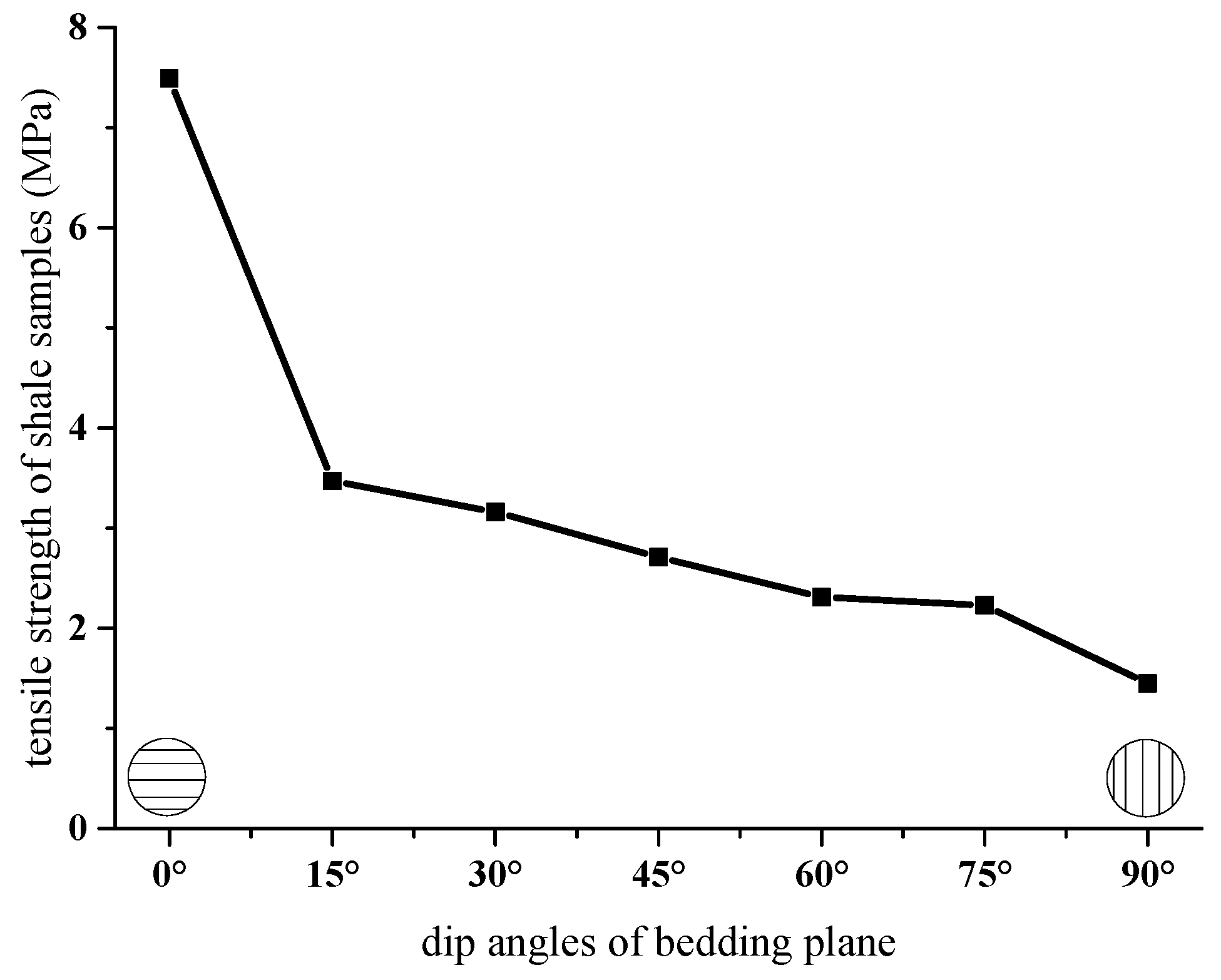

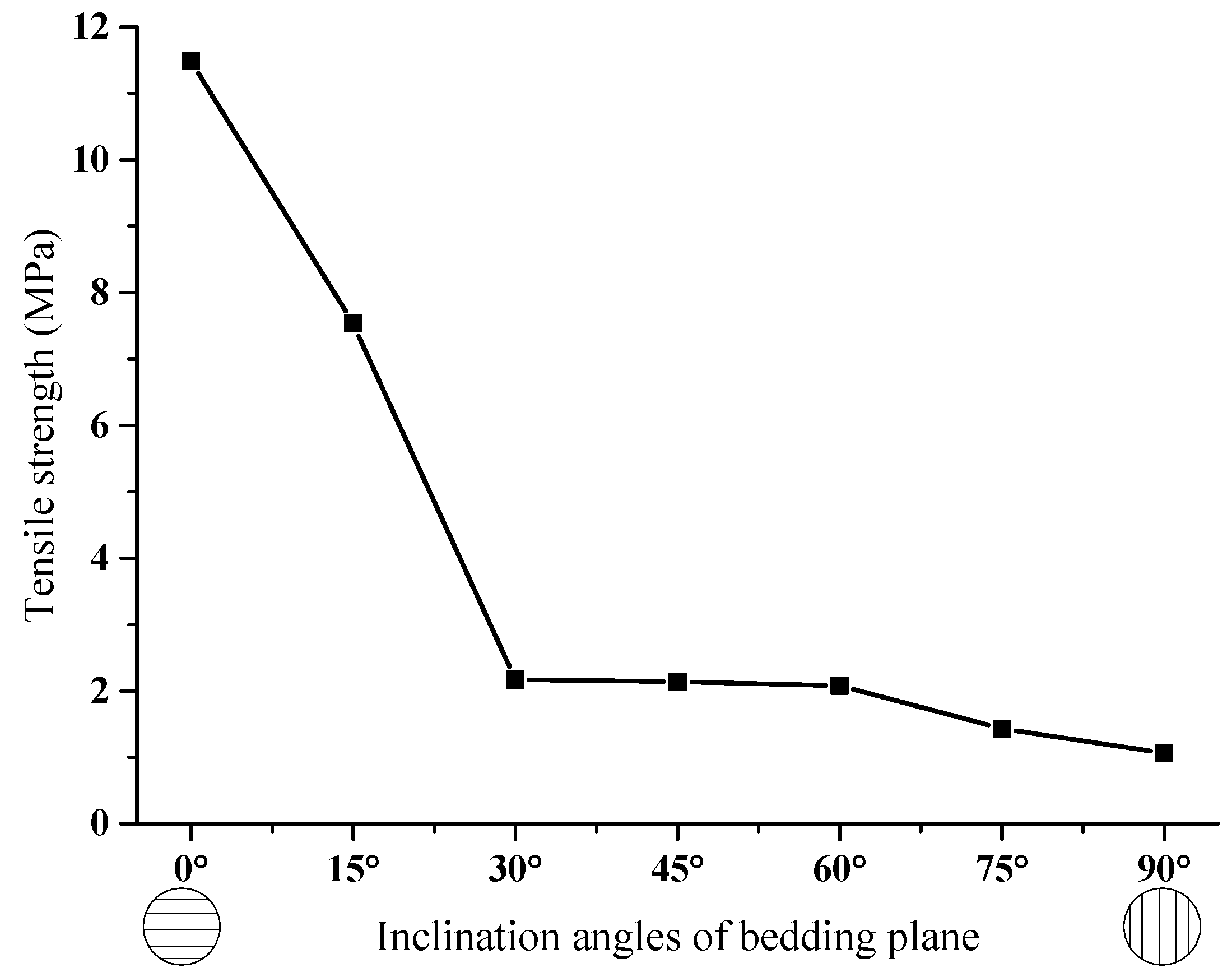



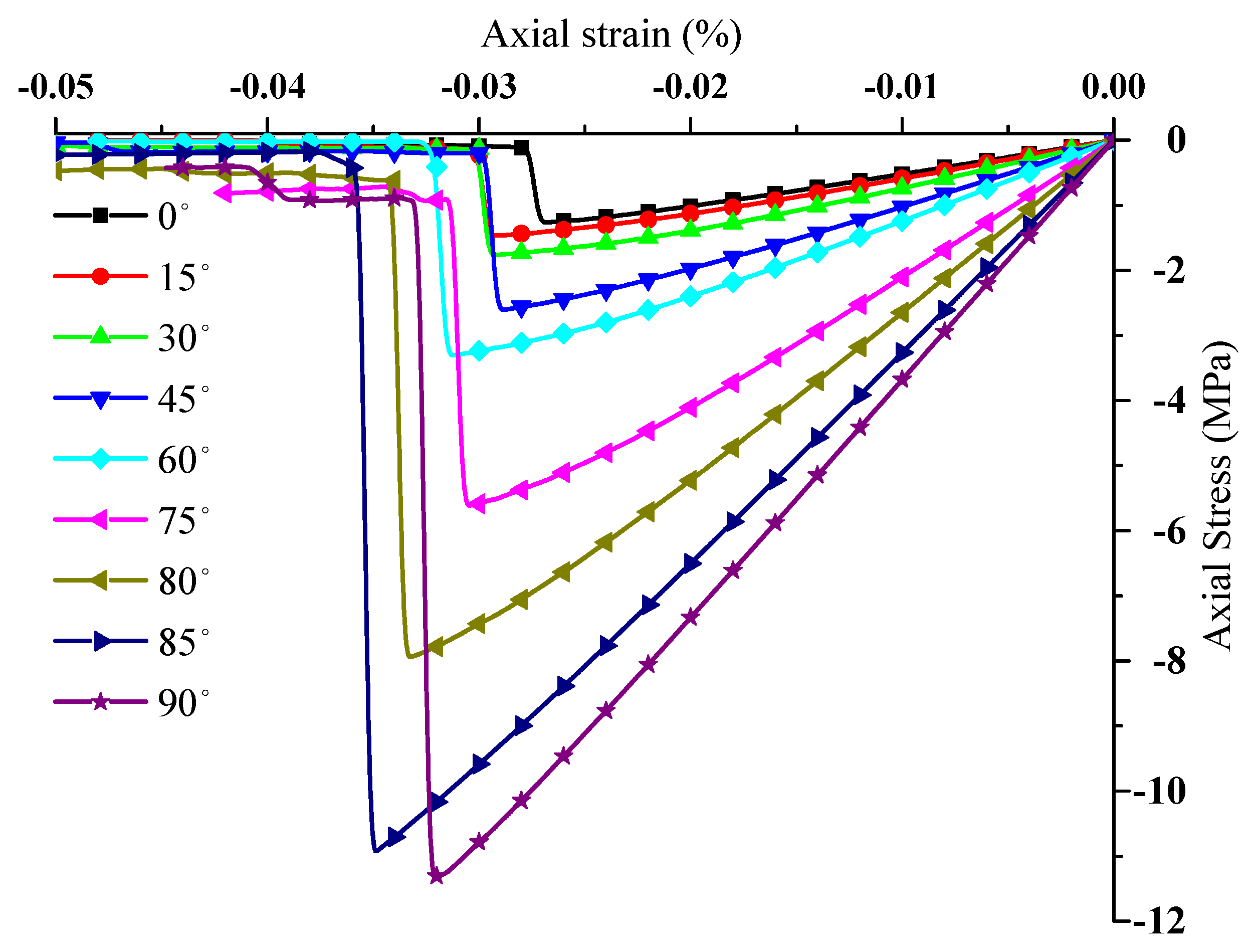



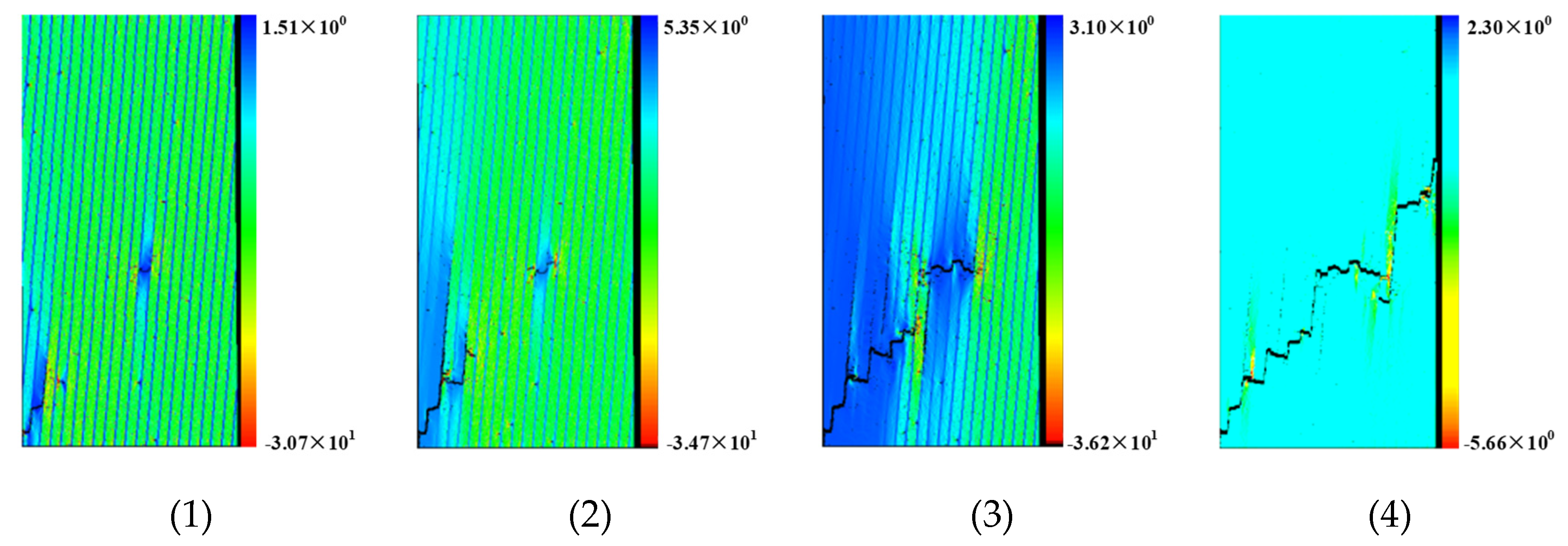

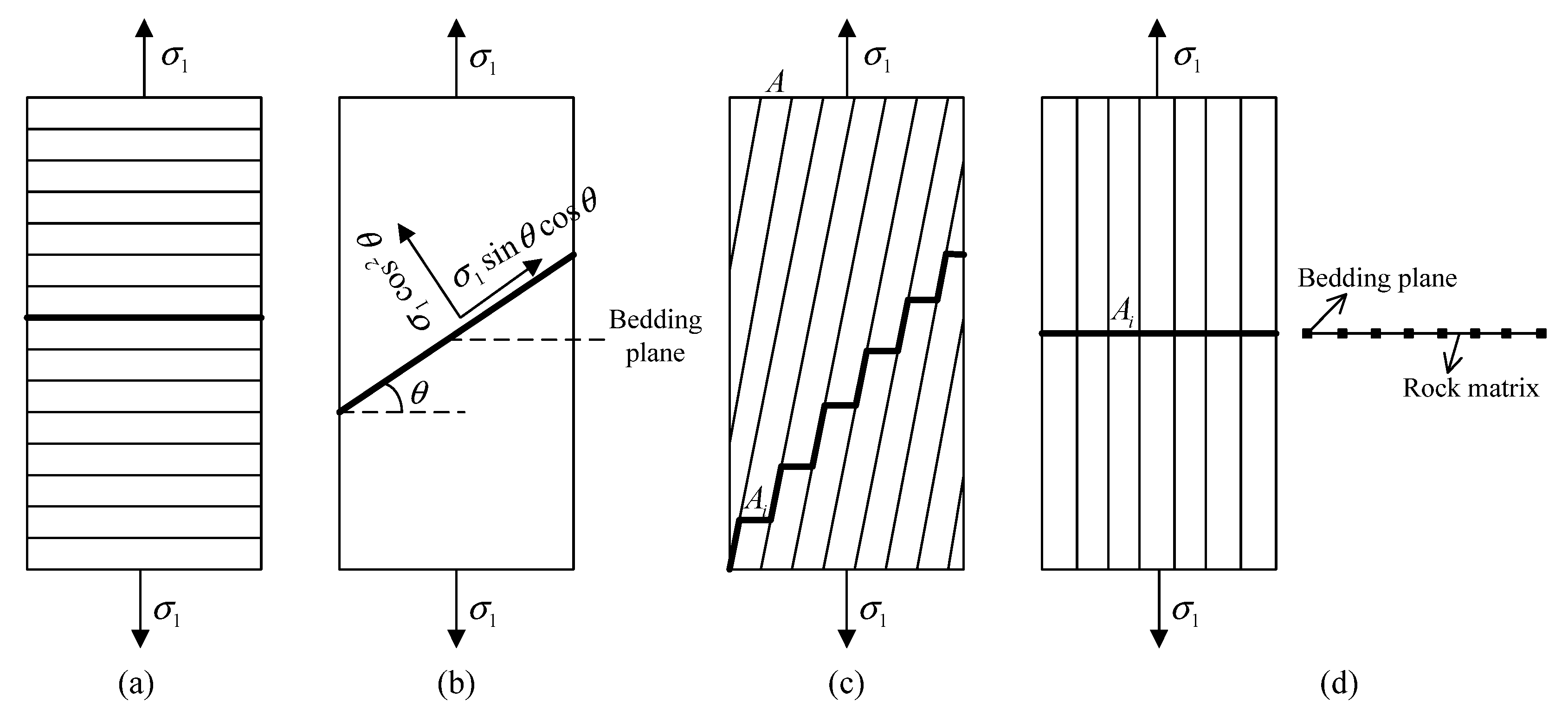


| Materials | Parameters | Elastic Modulus | Tensile Strength |
|---|---|---|---|
| Rock | Homogeneity index | 4 | 4 |
| Mean value | |||
| Joint | Homogeneity index | 3 | 3 |
| Mean value |
| Materials | ||
|---|---|---|
| Rock | 40,712.5 | 15.3 |
| Joint | 415.8 | 1.1 |
Publisher’s Note: MDPI stays neutral with regard to jurisdictional claims in published maps and institutional affiliations. |
© 2022 by the authors. Licensee MDPI, Basel, Switzerland. This article is an open access article distributed under the terms and conditions of the Creative Commons Attribution (CC BY) license (https://creativecommons.org/licenses/by/4.0/).
Share and Cite
Gao, M.; Liang, Z.; Jia, S.; Zou, J. Tensile Properties and Tensile Failure Criteria of Layered Rocks. Appl. Sci. 2022, 12, 6063. https://doi.org/10.3390/app12126063
Gao M, Liang Z, Jia S, Zou J. Tensile Properties and Tensile Failure Criteria of Layered Rocks. Applied Sciences. 2022; 12(12):6063. https://doi.org/10.3390/app12126063
Chicago/Turabian StyleGao, Min, Zhengzhao Liang, Shanpo Jia, and Jiuqun Zou. 2022. "Tensile Properties and Tensile Failure Criteria of Layered Rocks" Applied Sciences 12, no. 12: 6063. https://doi.org/10.3390/app12126063
APA StyleGao, M., Liang, Z., Jia, S., & Zou, J. (2022). Tensile Properties and Tensile Failure Criteria of Layered Rocks. Applied Sciences, 12(12), 6063. https://doi.org/10.3390/app12126063






